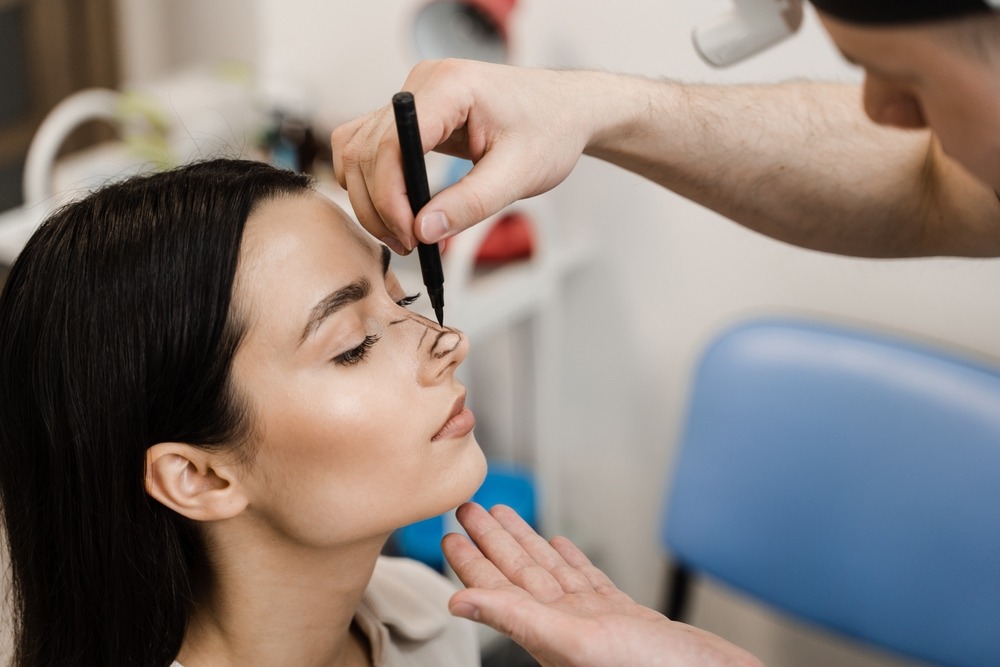Rhinoplasty
What are the Steps Involved in a Rhinoplasty Procedure: Know the Facts

by admin
31st August 2023
7 minutes read
Introduction
Rhinoplasty, commonly referred to as a “nose job,” is a surgical procedure aimed at reshaping the nose for functional or aesthetic purposes. It is a popular form of cosmetic surgery that can address structural abnormalities, improve breathing difficulties, and enhance facial harmony. A successful rhinoplasty procedure requires careful planning and execution, involving several essential steps. In this blog, we will explore the step-by-step process involved in a rhinoplasty procedure, from the initial consultation to the recovery phase.
I. Initial Consultation and Assessment
The first step in a rhinoplasty procedure is the initial consultation with a qualified and experienced plastic surgeon. During this consultation, the surgeon will assess your overall health, discuss your aesthetic goals, and conduct a thorough examination of your nose. The assessment may include:
Medical History:
The surgeon will inquire about any pre-existing medical conditions, previous surgeries, allergies, and medications you are currently taking. It is crucial to provide accurate information to ensure the safety and success of the procedure.
Aesthetic Goals:
Open and honest communication is essential during this stage. Discuss your concerns, expectations, and desired outcomes with the surgeon. Sharing reference images can help convey your vision effectively.
Nasal Examination:
The surgeon will carefully examine the external and internal structures of your nose. They will assess the shape, size, symmetry, and skin quality of your nose, as well as evaluate any functional issues that may need to be addressed.

II. Surgical Techniques
Once the initial consultation and assessment are complete, the surgical phase of rhinoplasty begins. The specific techniques used may vary depending on the individual’s needs and desired results. Some common surgical techniques include:
Closed Rhinoplasty:
In this technique, the incisions are made inside the nostrils, resulting in no visible external scars. The surgeon accesses the underlying nasal structures, such as bone and cartilage, to reshape and refine the nose.
Open Rhinoplasty:
Open rhinoplasty involves an additional incision across the columella, the strip of tissue between the nostrils. This technique provides better visibility and access to the nasal structures, making it suitable for complex cases or extensive reshaping requirements.
Septoplasty:
If you have a deviated septum, which can cause breathing difficulties, the surgeon may perform septoplasty during rhinoplasty. This procedure involves straightening the nasal septum to improve nasal airflow and functionality.
Tip Refinement:
Nasal tip refinement focuses on reshaping and repositioning the cartilage in the nasal tip to achieve a more defined and balanced appearance. Techniques such as suturing, cartilage removal, or grafting may be employed to refine the tip.
Reduction or Augmentation:
Depending on your goals, the surgeon may reduce the size of the nose by removing excess bone or cartilage. Conversely, augmentation techniques involve adding grafts or implants to increase the size or projection of the nose.
III. Steps Involved In Rhinoplasty
Here are the general steps of rhinoplasty:
Anesthesia:
On the day of the surgery, you will be given anesthesia to ensure your comfort throughout the procedure. The type of anesthesia used will depend on the surgeon’s recommendation and the complexity of the surgery. It can range from local anesthesia with sedation to general anesthesia.
Incisions:
Once the anesthesia takes effect, the surgeon will make the necessary incisions. The choice of incision technique depends on the specific goals of the surgery and the surgeon’s preferred approach. There are two primary techniques used in rhinoplasty:
a. Open Rhinoplasty:
In this approach, an incision is made across the columella, the strip of tissue between the nostrils. This provides the surgeon with direct access to the nasal structures for more extensive reshaping and reconstruction.
b. Closed Rhinoplasty:
In this technique, incisions are made inside the nostrils, leaving no visible external scars. This approach is suitable for less complex nasal deformities and requires less recovery time.
Reshaping the Nose:
Once the incisions are made, the surgeon will carefully reshape the underlying nasal structures. This may involve removing or rearranging cartilage, adjusting the nasal bones, or adding grafts to achieve the desired shape and symmetry. The surgeon will follow the preoperative plan and take into account your specific aesthetic goals.
Closure:
After reshaping the nose, the surgeon will close the incisions using sutures. If necessary, they may also place internal splints or packing to support the nasal structures and minimize postoperative bleeding.
Recovery and Postoperative Care:
After the procedure is complete, you will be monitored in a recovery area until the effects of the anesthesia wear off. The surgeon will provide specific postoperative instructions, which may include:
a. Pain management:
You may be prescribed pain medication to manage any discomfort or pain during the recovery period.
b. Nasal care:
You will be instructed on how to clean and care for your nose following the surgery. This may include gentle cleansing techniques and nasal irrigation.
c. Activity restrictions:
It is important to avoid strenuous activities, such as heavy lifting or vigorous exercise, during the initial healing phase. Your surgeon will provide guidance on when it is safe to resume normal activities.
d. Follow-up appointments:
Regular follow-up appointments will be scheduled to monitor your progress, remove any sutures or splints, and address any concerns or questions you may have during the recovery period.
IV. Recovery and Aftercare
After the rhinoplasty surgery, a recovery period is necessary for proper healing and optimal results. The following steps are typically involved in the recovery process:
Post-Operative Care:
You will be given specific post-operative instructions by your surgeon. This may include taking prescribed medications, using nasal sprays, and following a gentle cleansing routine for the nose.
Nasal Splint and Packing:
A nasal splint or cast is usually applied to the nose to provide support and protect the newly reshaped structures during the initial healing phase. Internal nasal packing may also be used to control bleeding and stabilize the septum.
Swelling and Bruising:
Swelling and bruising around the nose and eyes are common after rhinoplasty. Applying cold compresses and keeping your head elevated can help reduce these symptoms. It is important to note that swelling gradually subsides over time.
Rest and Activity Restrictions:
Adequate rest is crucial for a smooth recovery. Avoid strenuous activities, bending, and lifting heavy objects for a few weeks following the surgery. Your surgeon will provide specific guidelines regarding when you can resume normal activities.
Follow-Up Appointments:
Regular follow-up appointments will be scheduled to monitor your healing progress, remove any sutures, and assess the long-term results. During these appointments, you can discuss any concerns or questions you may have with your surgeon.
V. Choosing the Right Surgeon
Selecting a qualified and experienced rhinoplasty surgeon is paramount to achieving a successful outcome. Consider the following factors when choosing a surgeon:
Board Certification:
Ensure that the surgeon is board-certified in plastic surgery and has specific experience in performing rhinoplasty procedures.
Experience and Expertise:
Research the surgeon’s background, training, and experience in rhinoplasty. Review before-and-after photos of previous patients to assess their skills and aesthetic sensibilities.
Patient Testimonials and Reviews:
Read reviews and testimonials from previous patients to gauge their satisfaction and overall experience with the surgeon’s work.
Communication and Trust:
Choose a surgeon who listens to your concerns, answers your questions, and establishes a sense of trust and comfort.
Surgical Facility and Safety:
Verify that the surgeon operates in an accredited facility equipped with appropriate safety protocols and qualified medical staff.
Conclusion
Rhinoplasty is a complex surgical procedure that involves several important steps. From the initial consultation to the recovery phase, each step plays a crucial role in achieving the desired outcome. By understanding the process involved in a rhinoplasty procedure and selecting a skilled and experienced surgeon, you can embark on your journey to enhance the appearance and function of your nose successfully. Remember to prioritize open communication, realistic expectations, and diligent aftercare for the best rhinoplasty experience and results.
How Can Medfin Help?
Medfin is a daycare surgery expert providing access to the latest surgical procedures and top doctors in your city at affordable prices. Medfin provides you access to top doctors and surgeons with 10+ years of experience . With Medfin, you can leave your hassles behind and focus on your health. From instant consultations to paperwork assistance, we have got you covered with everything. So why wait? Call us today!
CATEGORIES
- ACL Reconstruction
- Anal Fissures
- Anal Fistula
- Appendicitis
- ASK A DOCTOR
- Benign Prostatic Hyperplasia
- Breast Lump Excision
- Cataract
- Circumcision
- Conditions & Diseases
- Cosmetology
- Covid-19
- Cure
- Endocrinology
- ENGLISH VIDEOS
- Eye Care
- Gallstones
- General Surgeries
- Government Schemes
- Gynaecology
- Gynecomastia
- Gynecomastia
- Health
- Health Insurance
- Hernia
- hindi
- Hip Arthoscopy
- Hip Replacement
- Hip Replacement Surgery
- Hydrocele
- Kannada
- Kidney Stones
- Knee Arthroscopic
- Laparoscopic
- LASER
- Latest Treatments
- Lifestyle
- Liposuction
- Medfin Stories
- Medicine
- Nephrology
- Ophthalmology
- Orthopaedic
- Paraphimosis
- Patient Testimonials
- PCL Reconstruction
- Phimosis
- Piles (Hemorrhoids)
- Pilonidal Sinus
- Proctology
- Prostate Artery Embolization
- Rhinoplasty
- Second Opinion
- Total Knee Replacement
- Uncategorised
- Urology
- uterine artery embolization
- Uterine Fibroids
- Varicocele
- Varicose Veins
- Vascular
- VIDEOS






